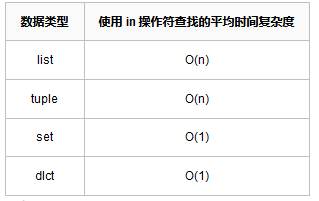前言
在Python中 in 操作符可以用于判断某个元素是否存在于当前对象中,而对于不同的Python对象,使用 in 操作符的处理效率是不一样的。
今天我们主要针对 4 种不同的Python数据类型进行学习:list列表、tuple元组、set集合、dict字典。
测试过程
我们用于测试的 4 种Python数据类型,分别为 tmp_list 、tmp_tuple、tmp_set、tmp_dict,测试过程中,它们所包含的元素都是相同的,均通过 random.randint(0, num) 随机生成,但它们的长度均为 num - 3 ,也就是说在 [0, num] 范围内,将有3个整数不在上面的对象中,我们需要把这3个整数找出来。
测试代码如下:
import time
import random
def demo(target, num):
time1 = time.time()
res = []
for i in range(num):
if i not in target:
res.append(i)
time2 = time.time()
print(\"结果:{},当前类型:{},耗时:{}\".format(res, type(target), time2 - time1))
num = 500
tmp_set = set()
while len(tmp_set) <= num - 3:
tmp_set.add(random.randint(0, num))
tmp_list = list(tmp_set)
tmp_tuple = tuple(tmp_set)
tmp_dict = {key: \"\" for key in tmp_set}
demo(tmp_list, num)
demo(tmp_tuple, num)
demo(tmp_set, num)
demo(tmp_dict, num)
当 num = 50 时,得到如下结果:
不包含的整数:[25, 31, 36],当前类型:<class \'list\'>,耗时:0.0
不包含的整数:[25, 31, 36],当前类型:<class \'tuple\'>,耗时:0.0
不包含的整数:[25, 31, 36],当前类型:<class \'set\'>,耗时:0.0
不包含的整数:[25, 31, 36],当前类型:<class \'dict\'>,耗时:0.0
当 num = 500 时,得到如下结果:
不包含的整数:[114, 329, 355],当前类型:<class \'list\'>,耗时:0.0059354305267333984
不包含的整数:[114, 329, 355],当前类型:<class \'tuple\'>,耗时:0.0052182674407958984
不包含的整数:[114, 329, 355],当前类型:<class \'set\'>,耗时:0.0
不包含的整数:[114, 329, 355],当前类型:<class \'dict\'>,耗时:0.0
当 num = 5000 时,得到如下结果:
不包含的整数:[445, 850, 3547],当前类型:<class \'list\'>,耗时:0.3342933654785156
不包含的整数:[445, 850, 3547],当前类型:<class \'tuple\'>,耗时:0.39918947219848633
不包含的整数:[445, 850, 3547],当前类型:<class \'set\'>,耗时:0.00099945068359375
不包含的整数:[445, 850, 3547],当前类型:<class \'dict\'>,耗时:0.0
当 num = 50000 时,得到如下结果:
不包含的整数:[9296, 18652, 32281],当前类型:<class \'list\'>,耗时:26.92029118537903
不包含的整数:[9296, 18652, 32281],当前类型:<class \'tuple\'>,耗时:25.956974506378174
不包含的整数:[9296, 18652, 32281],当前类型:<class \'set\'>,耗时:0.009968996047973633
不包含的整数:[9296, 18652, 32281],当前类型:<class \'dict\'>,耗时:0.009973287582397461
当 num = 55000 时,得到如下结果:
不包含的整数:[16086, 33891, 46161],当前类型:<class \'list\'>,耗时:52.91718029975891
不包含的整数:[16086, 33891, 46161],当前类型:<class \'tuple\'>,耗时:52.84810948371887
不包含的整数:[16086, 33891, 46161],当前类型:<class \'set\'>,耗时:0.009554624557495117
不包含的整数:[16086, 33891, 46161],当前类型:<class \'dict\'>,耗时:0.007979393005371094
当 num = 75000 时,得到如下结果:
不包含的整数:[23057, 35827, 69232],当前类型:<class \'list\'>,耗时:75.57932734489441
不包含的整数:[23057, 35827, 69232],当前类型:<class \'tuple\'>,耗时:64.49729013442993
不包含的整数:[23057, 35827, 69232],当前类型:<class \'set\'>,耗时:0.005983591079711914
不包含的整数:[23057, 35827, 69232],当前类型:<class \'dict\'>,耗时:0.005979776382446289
当 num = 100000 时,得到如下结果:
\'\'\'
学习中遇到问题没人解答?小编创建了一个Python学习交流群:711312441
寻找有志同道合的小伙伴,互帮互助,群里还有不错的视频学习教程和PDF电子书!
\'\'\'
不包含的整数:[22499, 22800, 29652],当前类型:<class \'list\'>,耗时:110.19707798957825
不包含的整数:[22499, 22800, 29652],当前类型:<class \'tuple\'>,耗时:109.08251285552979
不包含的整数:[22499, 22800, 29652],当前类型:<class \'set\'>,耗时:0.011965036392211914
不包含的整数:[22499, 22800, 29652],当前类型:<class \'dict\'>,耗时:0.009937524795532227
结论
通过上面的测试,我们可以看到,总体来说,list、tuple它们使用 in 操作符的查找效率相差不多,set、dict它们使用 in 操作符的查找效率相差不多,但随着查找数据量的增大,list、tuple的处理效率变得越来越慢,而set、dict的处理效率,将远远优于list及tuple。
list列表、tuple元组、set集合、dict字典,使用 in 操作符查找的平均时间复杂度如下:

当我们在处理数据量大且需频繁查找元素时,最好使用 set、dict ,这样将会大幅度提升处理速度。
来源:https://www.cnblogs.com/djdjdj123/p/16566682.html
本站部分图文来源于网络,如有侵权请联系删除。
 百木园
百木园